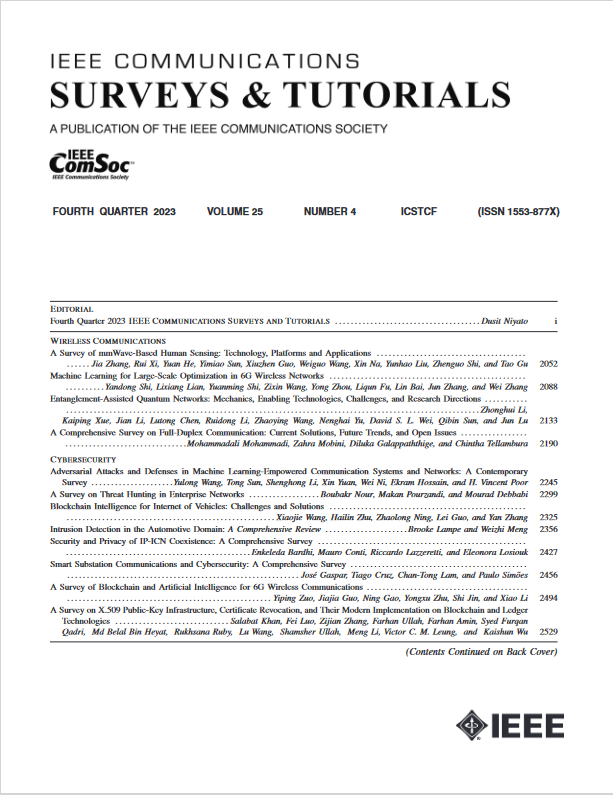RIS-Assisted Physical Layer Security in Emerging RF and Optical Wireless Communications Systems: A Comprehensive Survey
IF 34.4
1区 计算机科学
Q1 COMPUTER SCIENCE, INFORMATION SYSTEMS
引用次数: 0
Abstract
Security and latency are crucial aspects in the design of future wireless networks. Physical layer security (PLS) has received a growing interest from the research community in recent years for its ability to safeguard data confidentiality without relying on key distribution or encryption/decryption, and for its latency advantage over bit-level cryptographic techniques. However, the evolution towards the fifth generation wireless technology and beyond poses new security challenges that must be addressed in order to fulfill the unprecedented performance requirements of future wireless communications networks. Among the potential key-enabling technologies, reconfigurable intelligent surface (RIS) has attracted extensive attention due to its ability to proactively and intelligently reconfigure the wireless propagation environment to combat dynamic channel impairments. Consequently, the RIS technology can be adopted to improve the information-theoretic security of both radio frequency (RF) and optical wireless communications (OWC) systems. It is worth noting that the configuration of RIS in RF communications is different from that in optical systems at many levels (e.g., RIS materials, signal characteristics, and functionalities). This survey article provides a comprehensive overview of the information-theoretic security of RIS-based RF and optical systems. The article first discusses the fundamental concepts of PLS and RIS technologies, followed by their combination in both RF and OWC systems. Subsequently, some optimization techniques are presented in the context of the underlying system model, followed by an assessment of the impact of RIS-assisted PLS through a comprehensive performance analysis. Given that the computational complexity of future communications systems that adopt RIS-assisted PLS is likely to increase rapidly as the number of interactions between the users and infrastructure grows, machine learning (ML) is seen as a promising approach to address this complexity issue while sustaining or improving the network performance. A discussion of recent research studies on RIS-assisted PLS-based systems embedded with ML is presented. Furthermore, some important open research challenges are proposed and discussed to provide insightful future research directions, with the aim of moving a step closer towards the development and implementation of the forthcoming sixth-generation (6G) wireless technology.新兴射频和光无线通信系统中的 RIS 辅助物理层安全:全面调查
安全性和延迟是未来无线网络设计的重要方面。物理层安全(PLS)近年来受到了研究团体越来越多的关注,因为它能够在不依赖于密钥分发或加密/解密的情况下保护数据机密性,而且它比位级加密技术具有延迟优势。然而,向第五代及以上无线技术的发展提出了新的安全挑战,必须解决这些挑战,以满足未来无线通信网络前所未有的性能要求。在潜在的关键使能技术中,可重构智能表面(RIS)由于能够主动和智能地重新配置无线传播环境以对抗动态信道损伤而引起了广泛的关注。因此,RIS技术可以用于提高射频(RF)和光无线通信(OWC)系统的信息论安全性。值得注意的是,射频通信中RIS的配置在许多层面上与光学系统中的配置不同(例如,RIS材料、信号特性和功能)。本文对基于ris的射频和光学系统的信息安全进行了全面的综述。本文首先讨论了PLS和RIS技术的基本概念,然后讨论了它们在RF和OWC系统中的组合。随后,在基础系统模型的背景下提出了一些优化技术,然后通过全面的性能分析评估ris辅助PLS的影响。考虑到采用ris辅助PLS的未来通信系统的计算复杂性可能会随着用户和基础设施之间交互数量的增加而迅速增加,机器学习(ML)被视为一种有前途的方法,可以在维持或改善网络性能的同时解决这一复杂性问题。本文讨论了近年来基于gis辅助pls的嵌入式机器学习系统的研究进展。此外,还提出并讨论了一些重要的开放式研究挑战,以提供有见地的未来研究方向,目的是朝着即将到来的第六代(6G)无线技术的开发和实施迈进一步。
本文章由计算机程序翻译,如有差异,请以英文原文为准。
求助全文
约1分钟内获得全文
求助全文
来源期刊

IEEE Communications Surveys and Tutorials
COMPUTER SCIENCE, INFORMATION SYSTEMS-TELECOMMUNICATIONS
CiteScore
80.20
自引率
2.50%
发文量
84
审稿时长
6 months
期刊介绍:
IEEE Communications Surveys & Tutorials is an online journal published by the IEEE Communications Society for tutorials and surveys covering all aspects of the communications field. Telecommunications technology is progressing at a rapid pace, and the IEEE Communications Society is committed to providing researchers and other professionals the information and tools to stay abreast. IEEE Communications Surveys and Tutorials focuses on integrating and adding understanding to the existing literature on communications, putting results in context. Whether searching for in-depth information about a familiar area or an introduction into a new area, IEEE Communications Surveys & Tutorials aims to be the premier source of peer-reviewed, comprehensive tutorials and surveys, and pointers to further sources. IEEE Communications Surveys & Tutorials publishes only articles exclusively written for IEEE Communications Surveys & Tutorials and go through a rigorous review process before their publication in the quarterly issues.
A tutorial article in the IEEE Communications Surveys & Tutorials should be designed to help the reader to become familiar with and learn something specific about a chosen topic. In contrast, the term survey, as applied here, is defined to mean a survey of the literature. A survey article in IEEE Communications Surveys & Tutorials should provide a comprehensive review of developments in a selected area, covering its development from its inception to its current state and beyond, and illustrating its development through liberal citations from the literature. Both tutorials and surveys should be tutorial in nature and should be written in a style comprehensible to readers outside the specialty of the article.
 求助内容:
求助内容: 应助结果提醒方式:
应助结果提醒方式:


